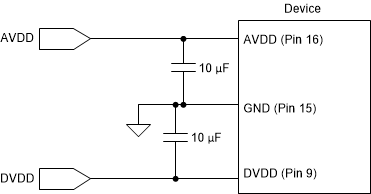ZHCSJ89B January 2019 – July 2022 ADS8353-Q1
PRODUCTION DATA
- 1特性
- 2应用
- 3说明
- 4Revision History
- 5Pin Configuration and Functions
- 6Specifications
- 7Detailed Description
- 8Application and Implementation
- 9Device and Documentation Support
8.3 Power Supply Recommendations
The device has two separate power supplies: AVDD and DVDD. The device operates on AVDD; DVDD is used for the interface circuits. AVDD and DVDD can be independently set to any value within the permissible ranges.
When using the device with the 2× VREF input range (CFR.B9 = 1), the AVDD supply voltage value defines the permissible voltage swing on the analog input pins. AVDD must be set as shown in Equation 9, Equation 10, and Equation 11 to avoid saturation of output codes and to use the full dynamic range on the analog input pins:
Decouple the AVDD and DVDD pins, as shown in Figure 8-5, with the GND pin using individual 10-µF decoupling capacitors.
 Figure 8-5 Power-Supply Decoupling
Figure 8-5 Power-Supply Decoupling